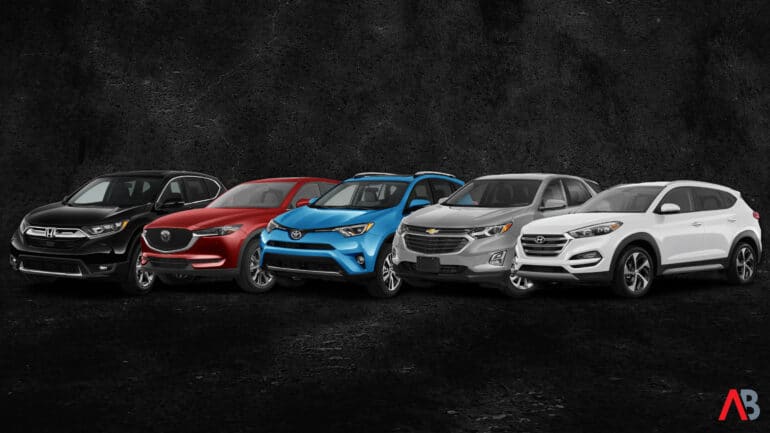Affiliate Disclosure: Automoblog and its partners may earn a commission when you use the services and tools here for extended warranties and auto loan comparisons. These commissions come to us at no additional cost to you. Our research team has carefully vetted dozens of extended warranty and auto loan providers. See our Privacy Policy to learn more.
Best Used Midsize SUVs: Summary Points
- The Honda CR-V, Mazda CX-5, and Toyota RAV4 are among the best used midsize SUVs in 2024.
- We looked at data from NHTSA, J.D. Power, the IIHS, and Kelley Blue Book for this list.
- Each midsize SUV here includes a rundown of its essential details, like the powertrain, fuel economy, safety ratings, and cargo space.
- The Honda CR-V and Toyota RAV4 offer the most cargo space on this list, while the Chevy Equinox’s available diesel powertrain has a combined EPA rating of 32 mpg.
Best Used Midsize SUVs: Quick Overview
Depending on your needs and budget, a brand-new sedan, minivan, or larger SUV might not be what you need. If so, a gently used midsize SUV may provide the “best of all worlds.” The asking price will be less than a new vehicle, the fuel economy will be good, and you will have a more spacious interior than a smaller SUV.
Below are five of the best used midsize SUVs that score high in safety, gas mileage, cargo space, and styling. Although three-row SUVs are available, everything on this particular list is a two-row (i.e., they will accommodate a max of five passengers).
Here are a few other helpful points to consider when reading through this list.
Terminology
You might come across several “industry terms” when researching a vehicle purchase. Those terms and phrases can include but are not limited to segment, class, compact, subcompact, subcompact SUVs, midsize crossover, crossover SUV (a blended term), and so on.
For this list, we have simplified things and rolled everything under the designation of “midsize SUVs,” although the term “midsize crossover” could also apply.
Given how SUVs have increased in size in recent years, the entries on this list might be considered compact SUVs (or small SUVs) today. At the time they were released, however, they were considered midsize.
You may also see certain terms shortened and abbreviated while researching your next vehicle purchase, most commonly front-wheel drive as FWD and all-wheel drive as AWD.
Proven Track Record
Some manufacturers on this list, like Honda and Toyota, have a lengthy track record of customer satisfaction with strong reliability ratings and safety scores.
Whether new or used, Toyota and Honda vehicles have a high level of build quality, on par with their luxury counterparts in Lexus and Acura, respectively.
Asking Price
We came up with an average range for each midsize SUV here. Mileage and condition, as a general rule of thumb, will have the most significant impact on the asking price of a used vehicle. Remember to look for potential red flags and only purchase a pre-owned vehicle after taking it for a test drive.
Further down, we offer insight into extended warranty providers for used SUVs and a helpful auto loan comparison tool with average interest rates for each lender.
Essential Info
Sometimes, when you look at a used vehicle on the lot, there isn’t much info on the one-sheet window sticker. That said, each midsize SUV below includes a summary of its essential details, like the powertrain, gas mileage, cargo space, safety features, and other options.
2018 Honda CR-V
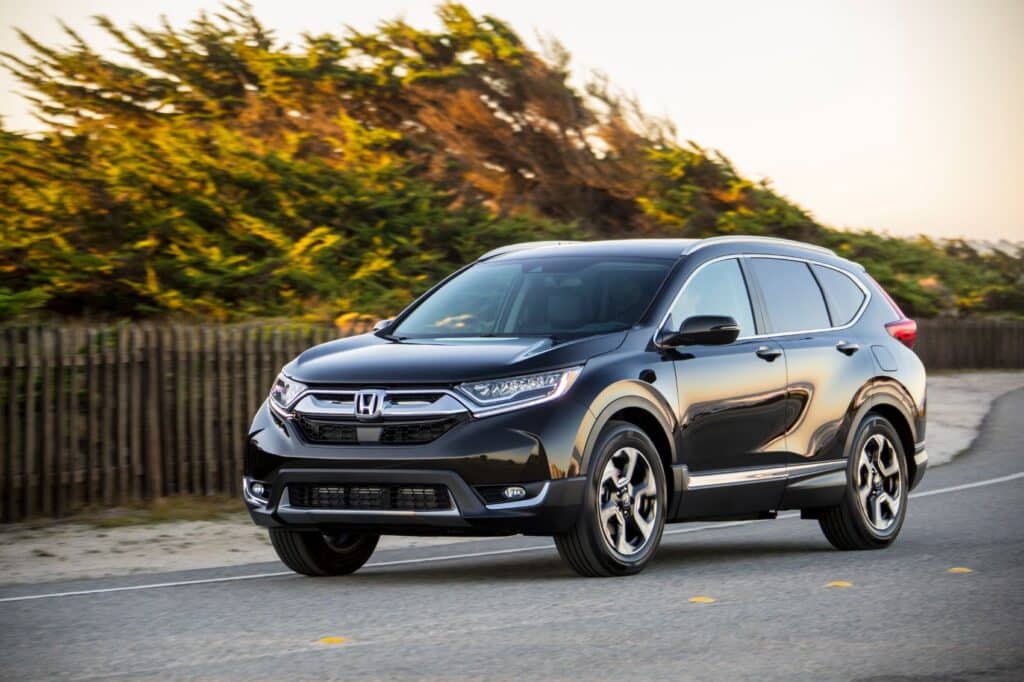
2018 Honda CR-V Overview
When the 2018 CR-V arrived at dealerships, it did so on the strength of a comprehensive redesign a year earlier.
The 2017 Honda CR-V debuted with a new body, a revised suspension with low-friction dampers, and an electric power steering system. Honda’s goal was to give the CR-V greater levels of on-road refinement for a more comfortable ride.
And it seemed to work! The 2018 CR-V, benefiting from the redesign a year earlier, arrived with a few feathers in its cap, including J.D. Power’s 2017 U.S. APEAL Study Award, a 2017 “Best New Car for Teens” designation by U.S. News & World Report, and a “Must Test Drive” award by Autotrader.
Why We Chose The 2018 Honda CR-V
Over the years, the CR-V has won numerous awards and accolades for its driving dynamics, fuel economy, safety features, and overall value (the 2018 CR-V still holds fairly good consumer rankings from Kelley Blue Book and J.D. Power).
Thanks to the redesign for the 2017 model year, the 2018 CR-V offered more rear-seat legroom and cargo space, the latter made easier to access via a “one-motion dive-down” 60/40 split rear seat. The 2018 Honda CR-V was optional with Apple CarPlay and Android Auto, SiriusXM, HD Radio, and Pandora.
Among the best features of the 2018 CR-V is Honda’s proprietary Advanced Compatibility Engineering (ACE) body structure, which provides increased occupant protection during frontal collisions. ACE is a network of connected structural elements within the CR-V that distributes crash energy more evenly throughout the front of the vehicle (ultimately reducing the force transferred into the cabin).
Powertrain
The EX, EXL, and Touring have a 1.5-liter turbo four-cylinder that creates 190 horsepower and 179 lb-ft. of torque. Entry-level LX modes have a naturally aspirated four-cylinder with 184 horsepower and 180 lb-ft. of torque. Both engines are connected to a continuously variable automatic transmission (CVT) with a Sport mode.
Regardless of the trim level or the engine, the 2018 Honda CR-V can tow a maximum of 1,500 lbs.
Fuel Economy
A 2018 Honda CR-V with the 2.4-liter non-turbo four-cylinder with front-wheel drive achieves an EPA-rated 26 in the city, 32 on the highway, and 28 combined. The 1.5-liter turbo with front-wheel drive is EPA-rated at 28/34 city/highway and 30 combined.
Cargo Space
Depending on the trim level, the 2018 Honda CR-V offers up to 105.9 cubic feet of interior passenger volume. With the rear seats up, the 2018 CR-V provides 39.2 cubic feet of cargo space. Folding it down reveals up to 75.8 cubic feet of space.
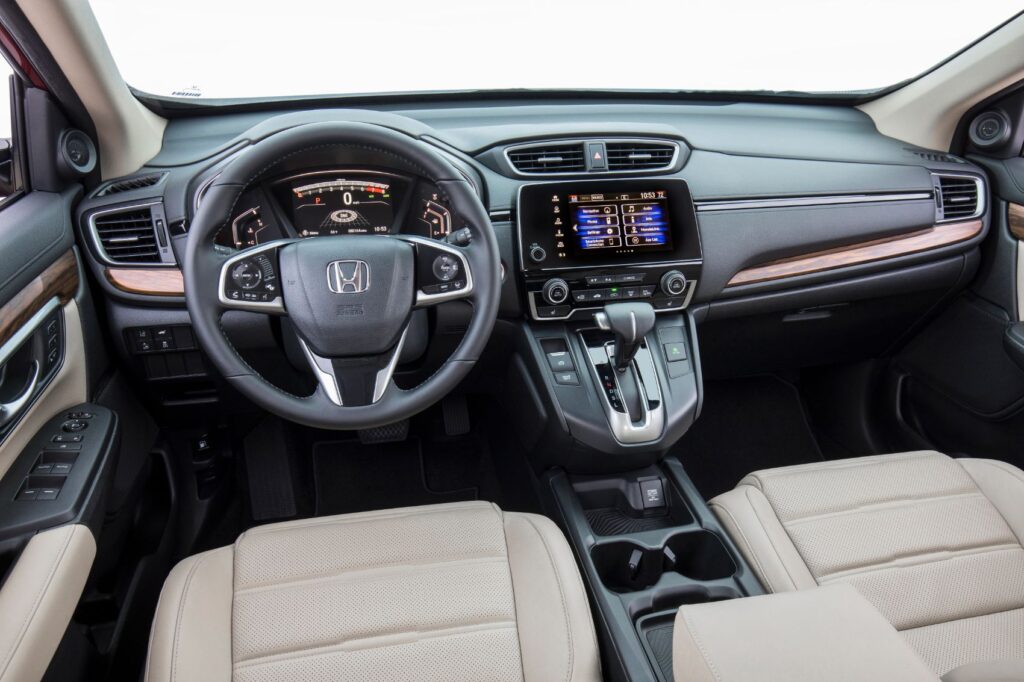
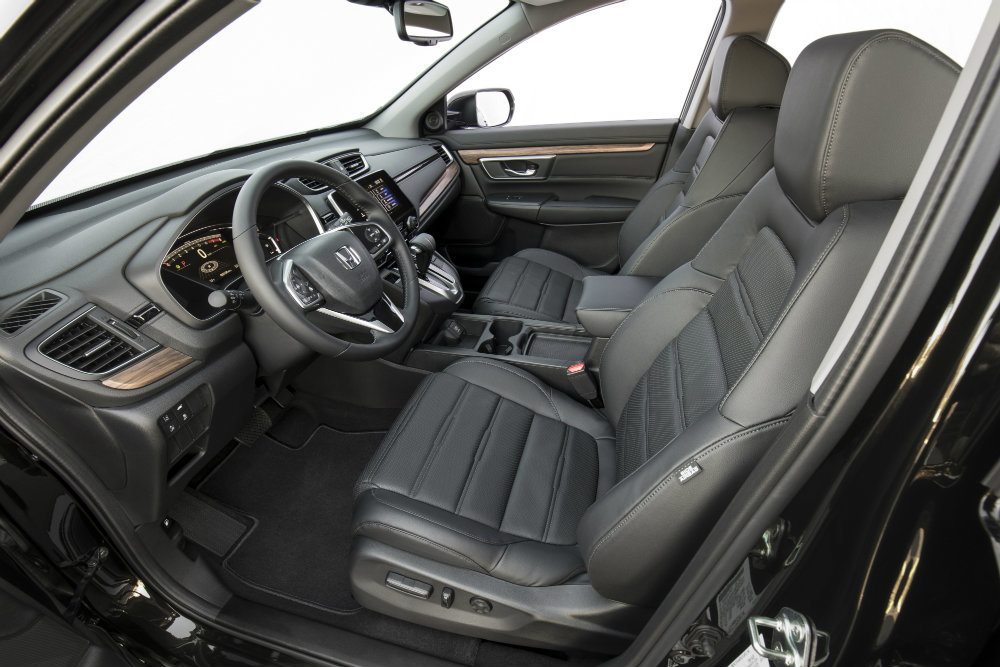
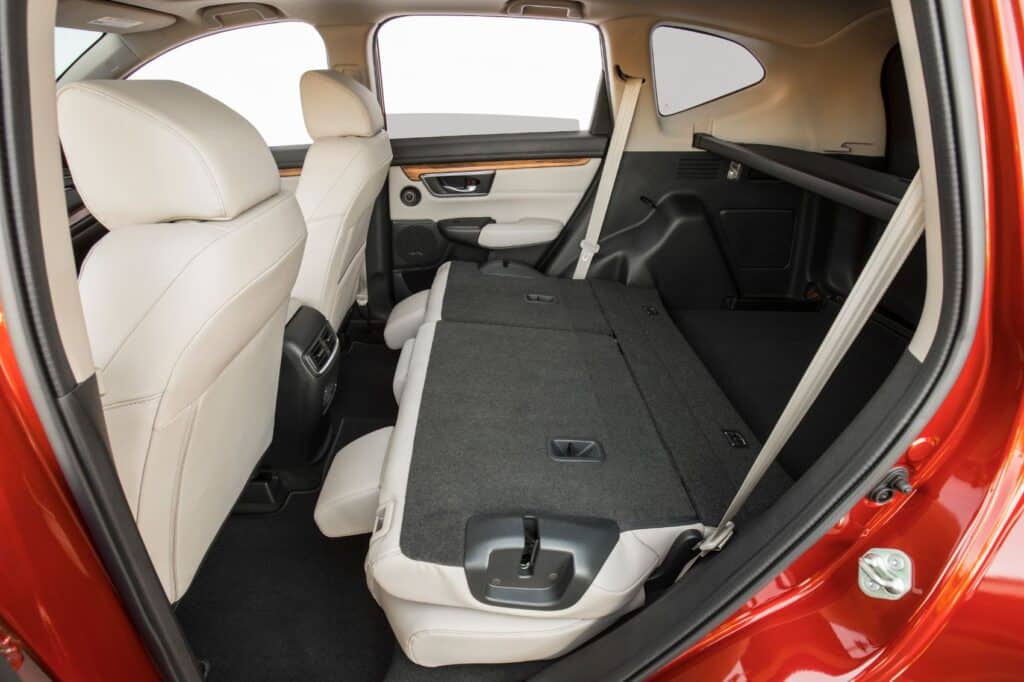
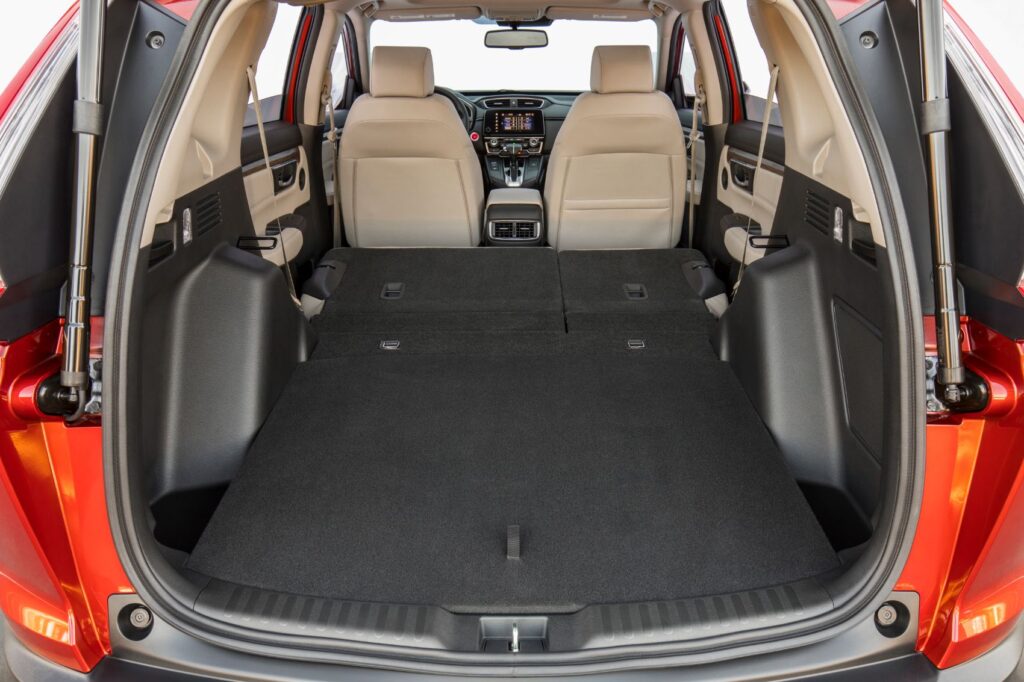
Safety Ratings & Features
The 2018 Honda CR-V was an IIHS Top Safety Pick and earned a five-star overall safety rating from NHTSA, two reasons why it’s on top of our best used midsize SUVs list.
All 2018 CRVs, except the base LX, had updated safety features as part of the Honda Sensing package. The package included collision mitigation braking, forward collision warning with pedestrian sensing, and road departure mitigation with lane departure alerts.
Other safety features included adaptive cruise control, automatic high beams, lane keep assist, and a blind spot monitor with cross-traffic alert.
2018 Honda CR-V Average Price
Depending on miles, condition, and trim level, a 2018 Honda CR-V could probably be purchased for between $19,000 and $25,000.
2019 Mazda CX-5
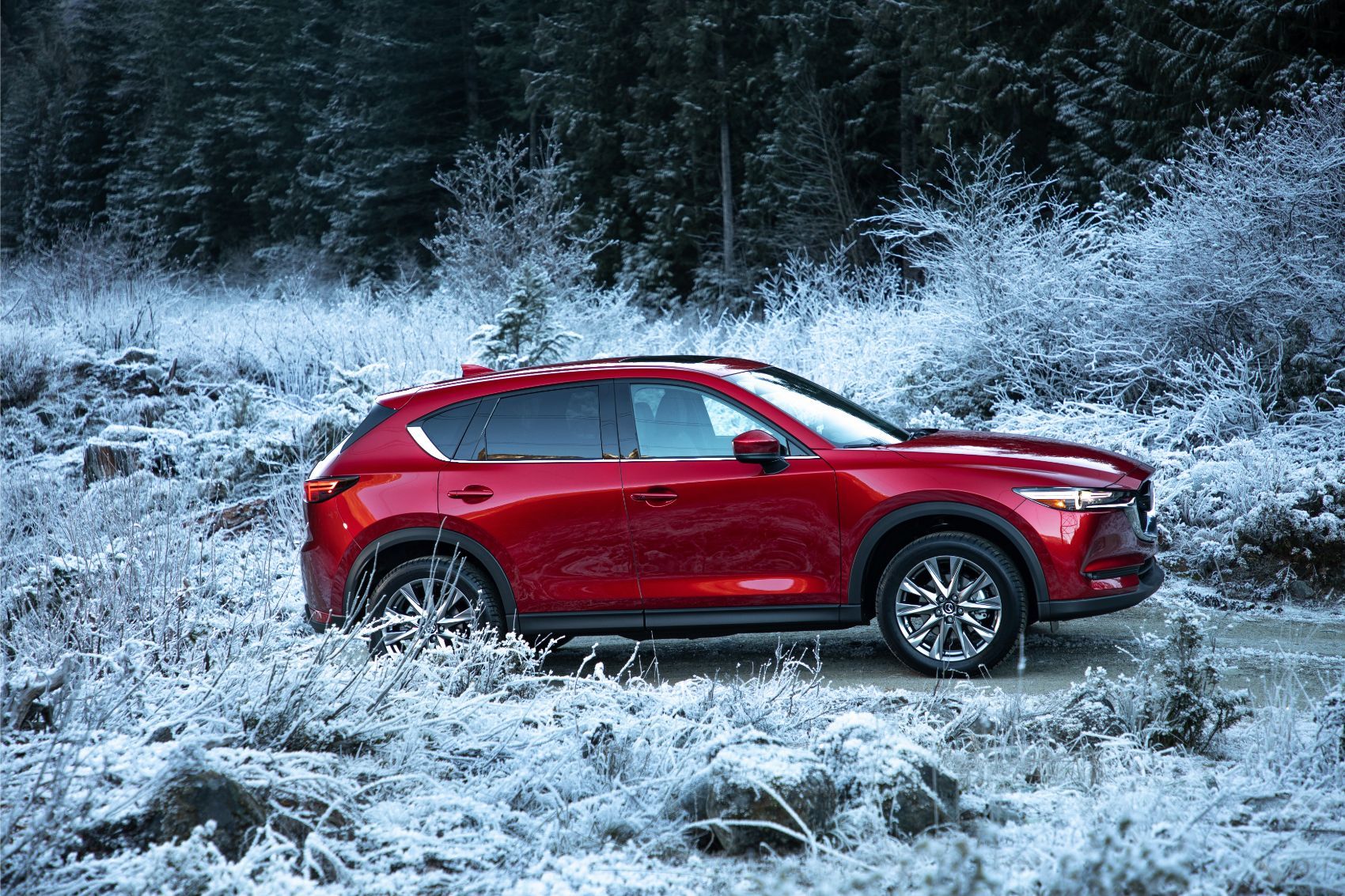
2019 Mazda CX-5 Overview
The Mazda CX-5 is at a crossroads since the Japanese automaker debuted the all-new CX-50 in 2023. Being larger and more rugged than the CX-5, the CX-50 continues to generate a lot of excitement for Mazda, with the 2024 models now on the market.
However, with the newness of the CX-50 comes a higher MSRP ($31,675 to $44,675, depending on the trim level for 2024), making the 2019 CX-5 a solid choice for a more affordable yet generously equipped midsize SUV.
Consumer scores for the 2019 Mazda CX-5 remain strong on Kelley Blue Book, while some consumer reviews on J.D. Power speak to the driving experience and reliability.
Why We Chose The 2019 Mazda CX-5
The Honda CR-V and Toyota RAV4 offer more interior and cargo space, but neither could hold a candle in the styling department: the CX-5 looks as good as when it debuted over 10 years ago. Behind the wheel, the 2019 CX-5 feels arguably more fun to drive than its pre-owned contemporaries.
Powertrain
The Sport, Touring, and Grand Touring have a 2.5-liter naturally-aspirated four-cylinder with 187 horsepower and 186 lb-ft. of torque. Grand Touring Reserve and Signature have a turbocharged 2.5-liter engine that produces up to 250 horsepower (93 octane fuel) and 310 lb-ft. of torque. Both engines are paired to a six-speed automatic.
The range-topping CX-5 Signature had the option at the time for a 2.2-liter turbo-diesel with 168 horsepower and 290 lb-ft. of torque.
Every 2019 Mazda CX-5 was available with the brand’s i-ACTIV all-wheel drive system. The towing capacity, when properly equipped, is 2,000 lbs.
Fuel Economy
The 2019 Mazda CX-5 i-ACTIV diesel returns an EPA-rated 27 in the city, 30 on the highway, and 28 combined, making it the fuel-sipper of the lot.
Meanwhile, the 2.5-liter engine with i-ACTIV all-wheel drive returns an EPA-estimated 22 in the city, 27 on the highway, and 24 combined.
Cargo Space
With the rear seats upright, the 2019 Mazda CX-5 provides just shy of 31 cubic feet of cargo space. Folding them down expands the available space to 59.6 cubic feet.
Safety Ratings & Features
The 2019 CX-5 was an IIHS Top Safety Pick+ with a five-star overall safety rating from NHTSA.
Mazda’s i-Activesense safety package was optional for the Sport and standard for the Touring and higher. The package included automatic headlights, automatic high beams, adaptive cruise control, lane departure warning, lane keeping assist, rain-sensing wipers, and Mazda’s Smart City Brake Support with pedestrian detection.
2019 Mazda CX-5 Average Price
Depending on miles, condition, and trim level, a 2019 Mazda CX-5 could range from around $16,000 to $23,000.
The entry-level CX-5 Sport was standard with LED daytime running lights, 12V power outlets, manual seats, and a seven-inch infotainment system with Bluetooth phone pairing.
Higher trim levels, like the Grand Touring Reserve, have power folding mirrors, power leather seats, a Bose 10-speaker stereo, front and rear USB ports, and Apple CarPlay and Android Auto.
If you can’t find a CX-5 you like on the used market, a late-model Mazda CX-9 with its third row might be worth considering.
2018 Toyota RAV4
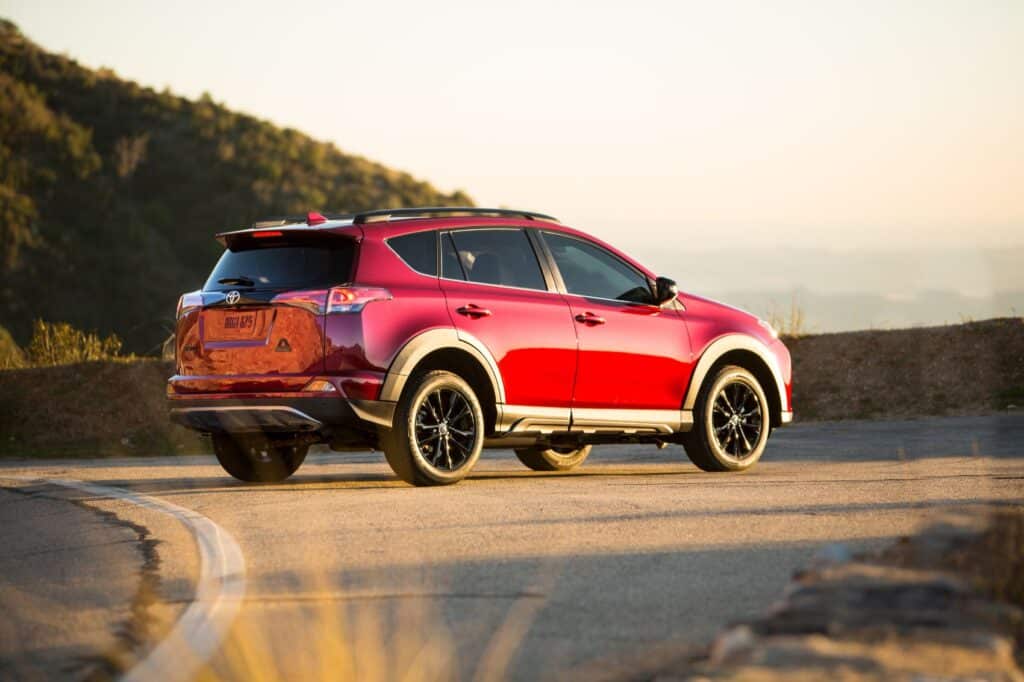
2018 Toyota RAV4 Overview
Before the fifth-generation 2019 RAV4 arrived with its full redesign, the 2018 RAV4 gave buyers the option for a fun Adventure trim level. The Adventure had sporty exterior accents, 18-inch five-spoke black alloy wheels with larger tires, and a higher ground clearance (6.5 inches vs. the standard 6.1 inches).
Why We Chose The 2018 Toyota RAV4
Toyota’s sterling reliability reputation and durability merits are hard to ignore, and consumer reviews on Kelley Blue Book and J.D. Power alike mention the 2019 RAV4’s overall reliability.
Toyota Safety Sense P (TSS-P), a collection of advanced driving aids, was also standard for every 2018 Toyota RAV4 regardless of the trim level.
The high-strength steel body structure benefited the 2018 RAV4’s ride and handling, while the MacPherson strut front and double-wishbone multi-link rear suspension smoothed out bumps and other road imperfections.
Powertrain
Under the hood of the 2018 Toyota RAV4 is a 2.5-liter four-cylinder with 176 horsepower and 172 lb-ft. of torque. The engine was paired to a six-speed automatic with driver-selectable modes, including Eco and Sport. Front-wheel drive was standard, but all-wheel drive was optional at the time.
When properly equipped, the 2018 Toyota RAV4 can tow up to 1,500 lbs.
Fuel Economy
The 2018 Toyota RAV4’s fuel mileage will vary slightly depending on the trim level. The LE and XLE with front-wheel drive return the best numbers, an EPA-rated 23 in the city, 30 on the highway, and 26 combined.
A hybrid powertrain was also available for the 2018 Toyota RAV4, which offers an EPA-rated 34 in the city, 30 on the highway, and 32 combined.
Cargo Space
The 2018 RAV4 has 37.2 inches of rear legroom and 38.4 cubic feet of cargo space with the rear seats upright. When folded, the available cargo space expands to 73.4 cubic feet.
Safety Ratings & Features
The 2018 Toyota RAV4 was an IIHS Top Safety Pick with a five-star overall safety rating from NHTSA.
The standard Toyota Safety Sense P package (TSS-P for short) included a pre-collision system with pedestrian detection, lane departure alert with steering assist, automatic high beams, and adaptive cruise control.
2018 Toyota RAV4 Average Price
Depending on the miles, condition, and trim level, a 2018 RAV4 may sell between $17,000 and $22,000.
The LE, XLE, and Adventure were standard with the Entune Audio and Entune Multimedia Bundle. Key features included a 6.1-inch touchscreen display, a CD player, an auxiliary audio jack, a USB port with iPod connectivity, and Bluetooth phone pairing with music streaming.
Meanwhile, the Platinum offered SofTex heated seats, a heated steering wheel, ambient lighting, a remote power liftgate, and a frameless auto-dimming rearview mirror with HomeLink.
2018 Chevy Equinox
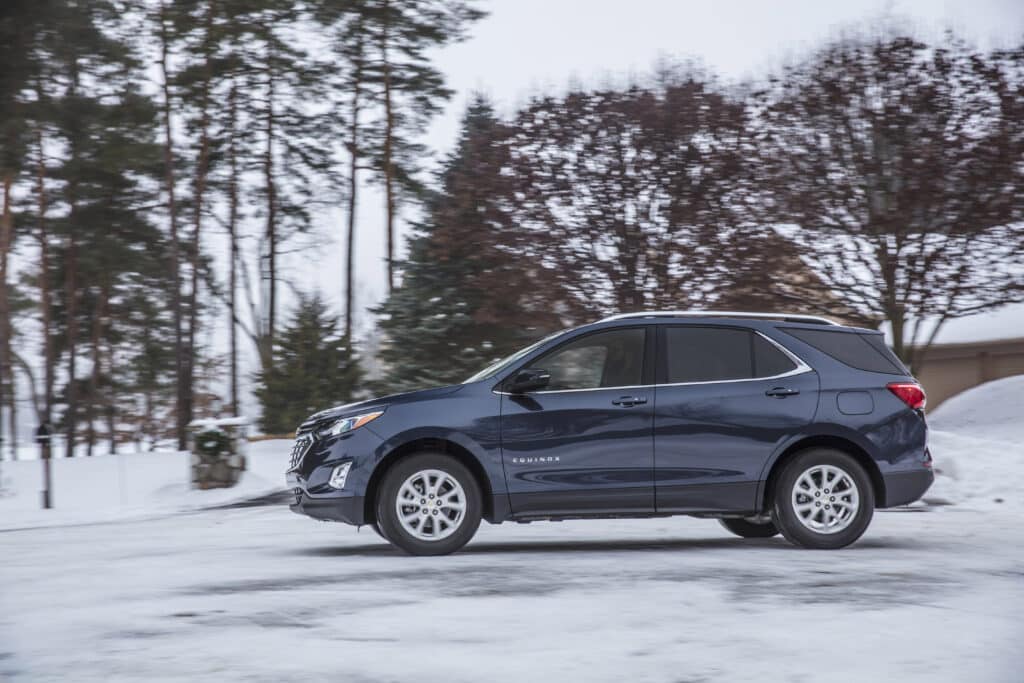
2018 Chevy Equinox Overview
Fresh from an extensive redesign at the time, the 2018 Equinox was a solid competitor to the Ford Edge, Nissan Murano, Dodge Durango, Jeep Grand Cherokee, and Kia Sorento.
Key features included three engine options (one was a diesel), Apple CarPlay and Android Auto, and a nearly flat load floor for easier cargo hauling. An OnStar 4G LTE Wi-Fi hotspot was also available.
Why We Chose The 2018 Chevy Equinox
Benefiting from its then-new design and connectivity technology, along with updated powertrains, the 2018 Chevrolet Equinox was a marked improvement over prior generations of the vehicle in nearly every way. Customer reviews are favorable on J.D. Power, with high marks given for the driving experience and reliability.
Although the 2018 Traverse, with its standard V6 engine and third row, would also be a good pick if you have your heart set on a pre-owned Chevy, our preference is still the Equinox for its overall value.
Powertrain
The 2018 Equinox was offered with three engines: a 1.5-liter turbo, a 2.0-liter turbo, and a 1.6-liter turbo-diesel. All-wheel drive was optional at the time.
The little 1.5-liter turbo produced 170 horsepower and 203 lb-ft. of torque, while the slightly larger 2.0-liter turbo bumped the 2018 Equinox up to 252 horsepower and 260 lb-ft. of torque. The diesel powertrain for the 3LT and Premier 3LZ generated 137 horsepower and a healthy 240 lb-ft. of torque.
The 1.5-liter turbo was paired to a six-speed automatic (Hydra-Matic 6T40), the 2.0-liter turbo to a nine-speed automatic (Hydra-Matic 9T50), and the diesel to a six-speed automatic (Hydra-Matic 6T45).
With the 2.0-liter turbo, the 2018 Chevy Equinox had a max towing capacity of 3,500 lbs.
Fuel Economy
As expected, the diesel with front-wheel drive was a fuel miser, returning an EPA-rated 28 in the city, 39 on the highway, and 32 combined.
The 1.5-liter turbo with front-wheel drive returns an EPA-estimated 26 in the city, 32 on the highway, and 28 combined. Finally, the turbocharged 2.0-liter engine with front-wheel drive achieves an EPA rating of 22/29 city/highway and 25 combined.
The 2018 Chevy Equinox was also 400 lbs. lighter than prior model years, which helped with real-world fuel efficiency.
Cargo Space
With the rear seats upright, the 2018 Equinox offers nearly 30 cubic feet of cargo space, expanding to 63.5 cubic feet when folded.
New at the time for the Equinox was a “kneeling” rear seat style that allowed the bottom cushions to tilt in a way that created a nearly flat floor when lowered. The design provides an added level of practicality and versatility.
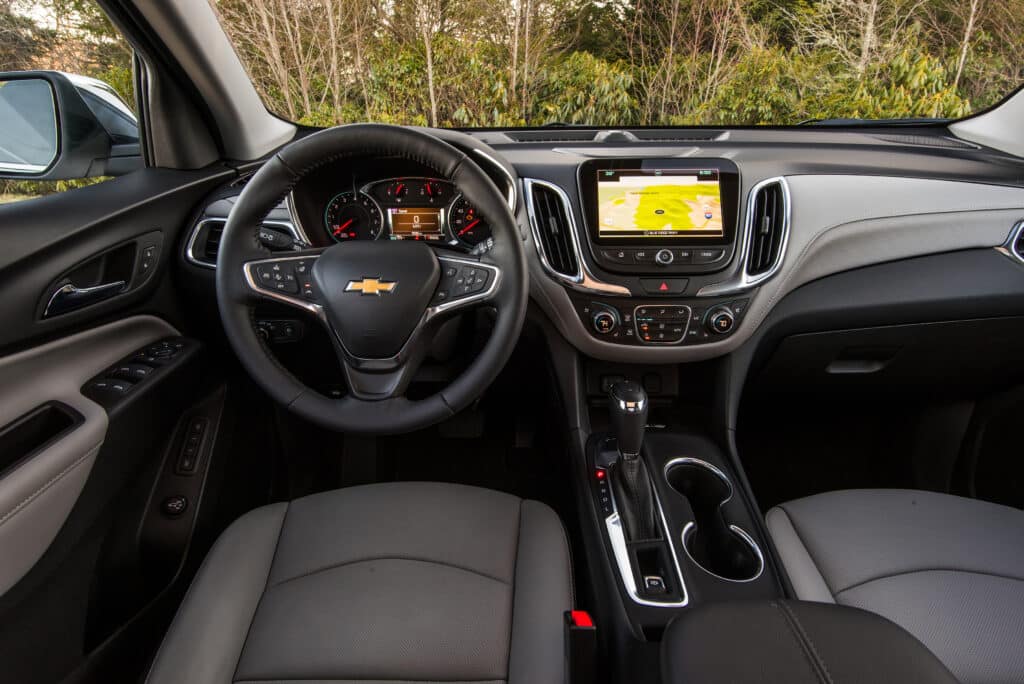
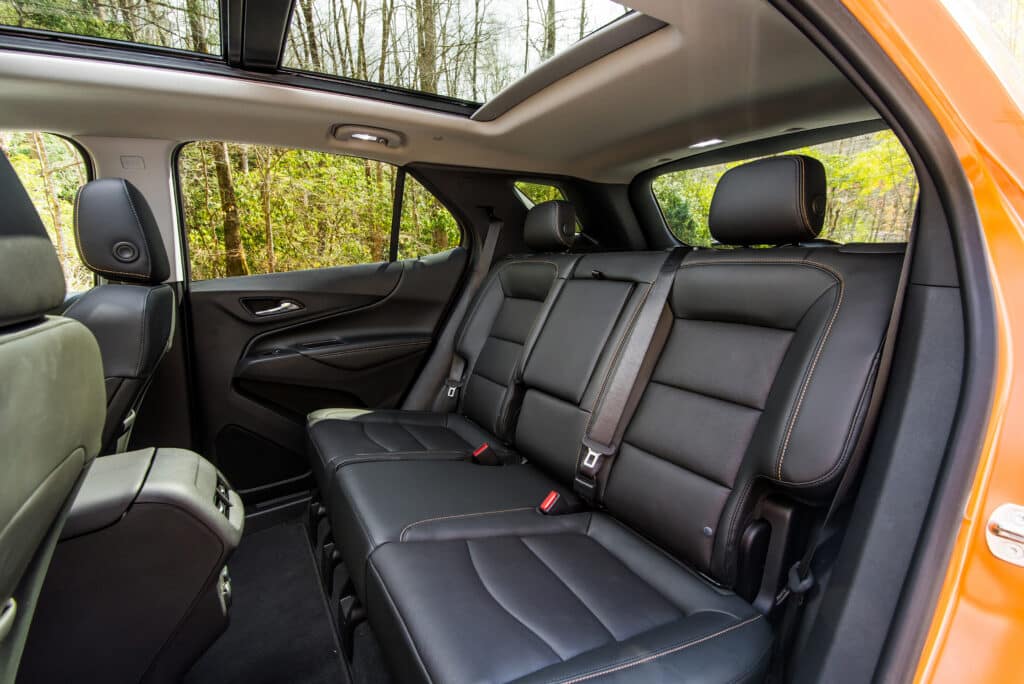
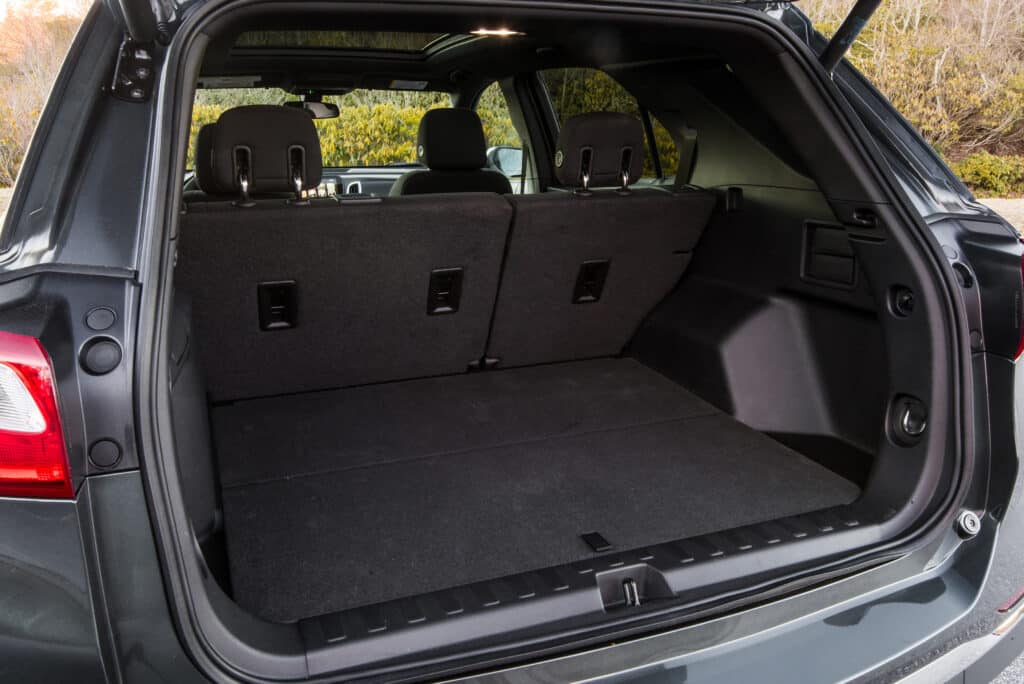
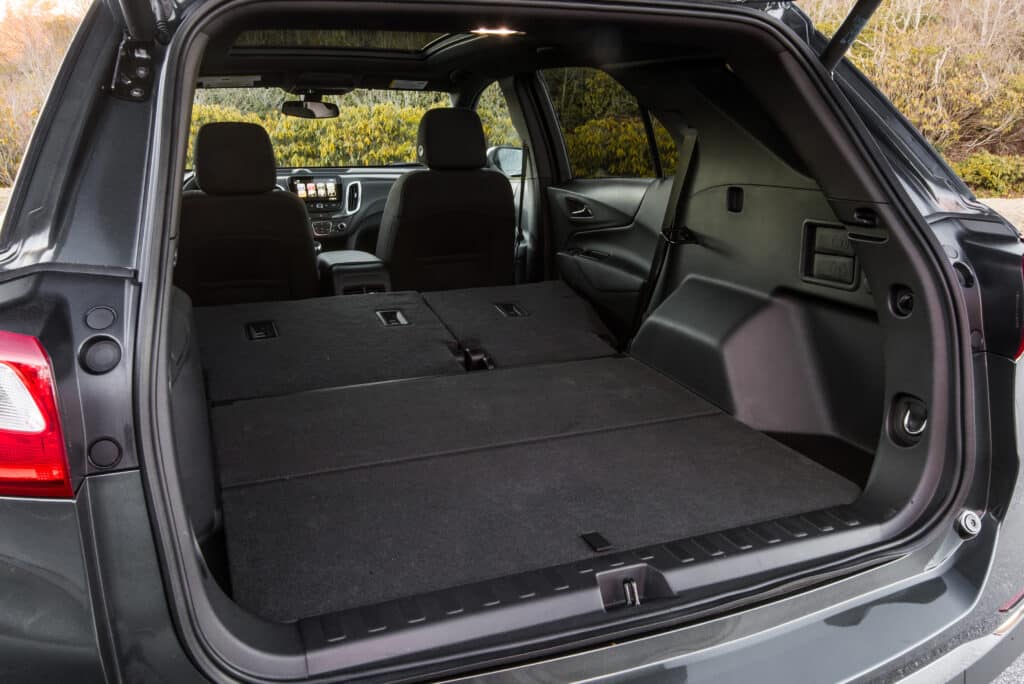
Safety Ratings & Features
The 2018 Chevrolet Equinox earned a four-star overall safety rating from NHTSA and a series of Good crashworthiness scores from the IIHS.
The 2018 Equinox came with two Driver Confidence Packages.
Available on LT and standard on Premier, the regular Driver Confidence Package included rear park assist, rear cross-traffic alert, side blind zone alert, and lane change alert, among other features.
The Driver Confidence II Package, available on the Premier, included low-speed forward automatic braking, forward collision alert, lane keep assist, lane departure warning, and a surround-view camera, among other features.
2019 Chevy Equinox Average Price
Depending on miles, condition, and trim level, a 2018 Equinox may sell between $12,000 and $18,500.
Dual-zone automatic climate control and heated seats were standard for the Premier, but you might find an LT with both – although only the Premier had the option for heated rear seats and a heated steering wheel. An auxiliary electric cabin heater was standard on 3LT and 3LZ.
A power sunroof was available for the LT and Premier, but only the Premier had standard wireless charging. Ventilated front seats were optional for the 3LZ.
2018 Hyundai Tucson
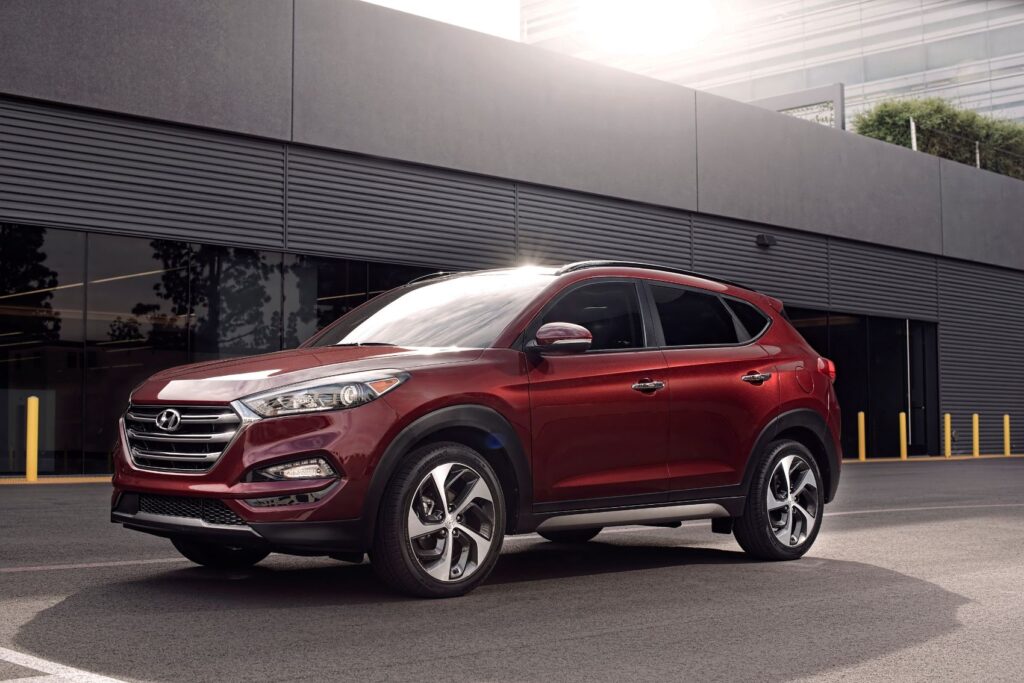
2018 Hyundai Tucson Overview
The 2018 Hyundai Tucson was mainly a “carryover model” due to an extensive redesign in 2016.
As part of the 2016 redesign, the Tucson benefited from new styling changes, updated advanced safety features, a larger interior with more soft-touch points, and a new Gamma engine family for increased fuel efficiency.
New connectivity features for the 2018 model year included a more user-friendly display with Apple CarPlay and Android Auto.
Why We Chose The 2018 Hyundai Tucson
As detailed by Kelley Blue Book, the 2018 Tucson did not have the cargo space as some of its competitors, but it still offered buyers a stylish and fuel-efficient SUV at an affordable MSRP. We agree with KBB’s assessment, as Hyundai has always held a high value for the dollar proposition in our minds.
On the road, the 2018 Tucson was as comfortable and refined as any midsize SUV at the time, thanks to a unique shock-absorber mounting structure that dramatically improved ride and handling while cutting road noise.
Powertrain
2018 Tucson SE, SEL, and SEL Plus will have a 2.0-liter four-cylinder with 164 horsepower and 151 lb-ft. of torque. The engine is connected to a six-speed automatic with an overdrive lock-up torque converter for better fuel economy on the highway.
Higher trim levels, like the Value and Limited, had a 1.6-liter turbo four-cylinder with 175 horsepower and 195 lb-ft. of torque. The engine was paired with a seven-speed dual-clutch transmission, which was new for Hyundai at the time. The seven-speed dual-clutch automatic made the Tucson more engaging to drive (Hyundai would use a dual-clutch transmission again a short time later for the popular Kona crossover).
Front-wheel drive was standard for the 2018 Tucson, although all-wheel drive was optional.
Fuel Economy
The 2018 Tucson, with the naturally aspirated 2.0-liter four-cylinder and front-wheel drive, returned an EPA average of 23/30 city/highway and 26 combined. All-wheel drive models were rated at 21/26 city/highway and 23 combined.
The 1.6-liter turbo with front-wheel drive has an EPA rating of 25 in the city, 30 on the highway, and 27 combined. All-wheel drive models are 24/28 city/highway and 25 combined.
Every 2018 Tucson has a 16.4-gallon fuel tank.
Cargo Space
With the rear seats upright, the 2018 Hyundai Tucson offers 31 cubic feet of cargo space, expanding to 62 cubic feet when folded. At the time, Hyundai had enlarged the rear liftgate opening and gave the 60/40 rear seatbacks a greater range of adjustability to accommodate cargo.
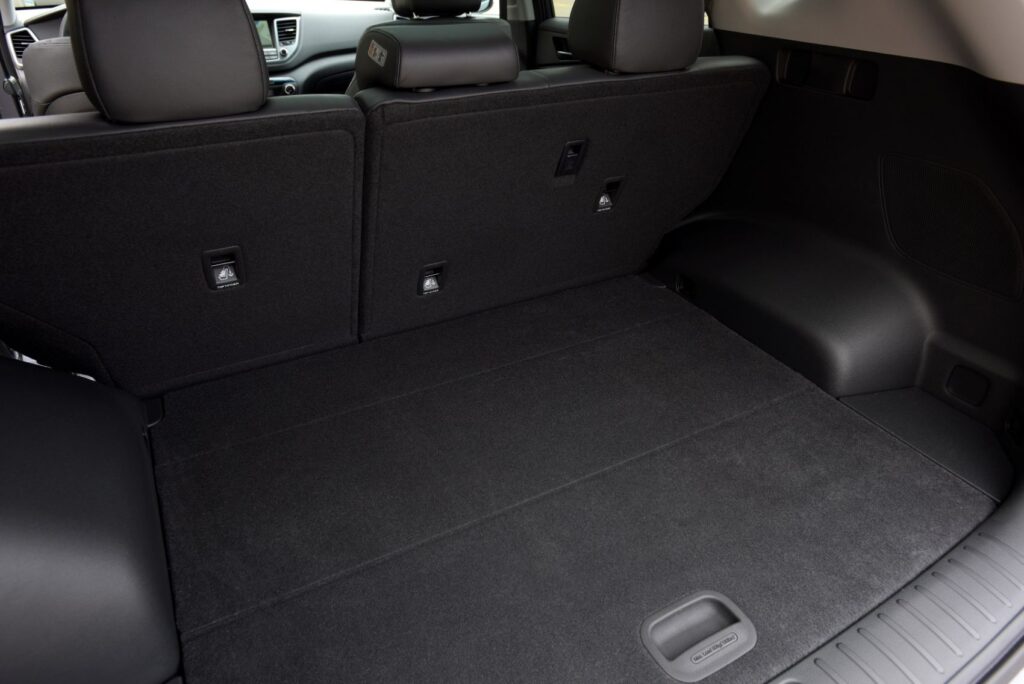
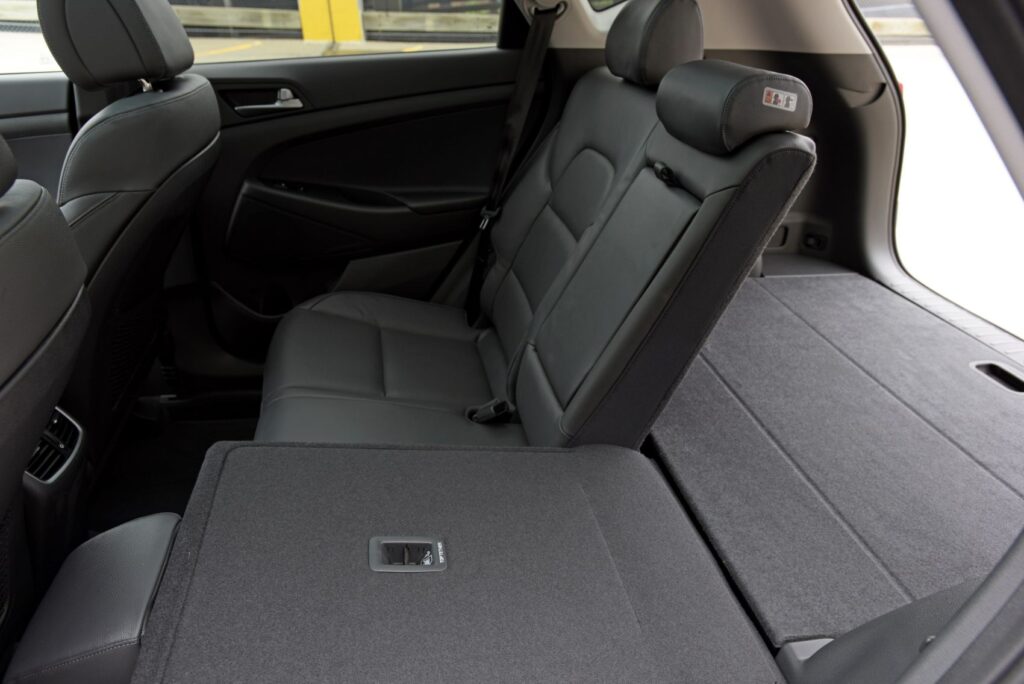
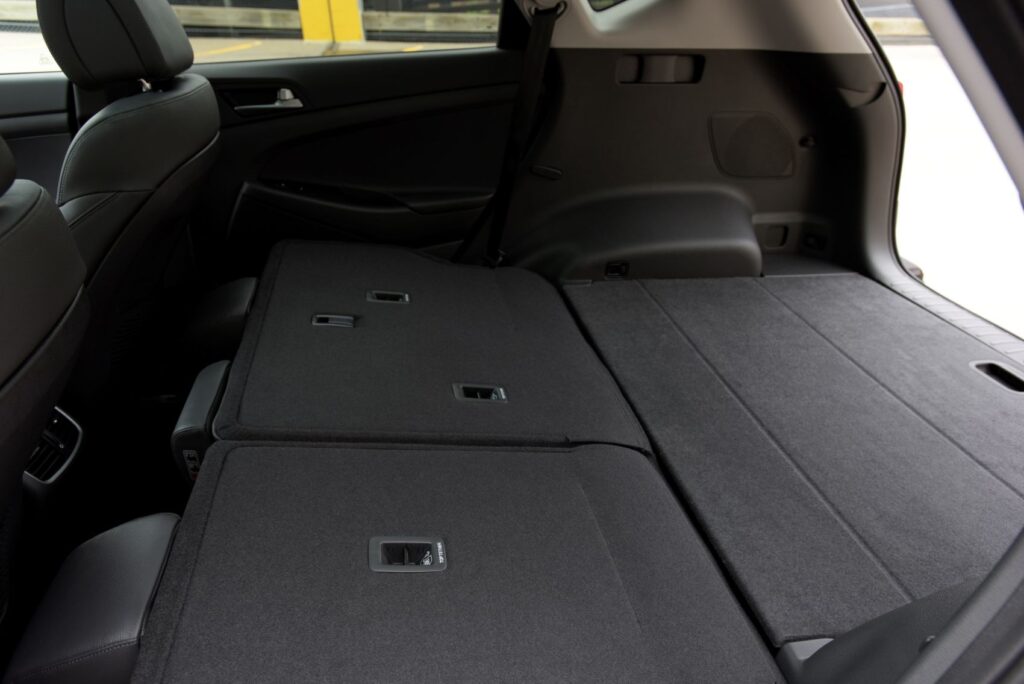
Safety Ratings & Features
The 2018 Hyundai Tucson is an IIHS Top Safety Pick with a five-star overall safety rating from NHTSA.
Depending on the trim level, a pre-owned 2018 Hyundai Tucson may have advanced safety features like automatic emergency braking with pedestrian detection, lane departure warning, and blind spot detection with rear cross-traffic alert, among others.
2018 Hyundai Tucson Average Price
Depending on the miles, condition, and trim level, a 2018 Tucson may sell between $14,000 and $19,000.
Limited models with all-wheel drive had a heated steering wheel, while SEL models had Sirius XM. The Value trim level was standard with a panoramic sunroof, hands-free liftgate, and dual-zone climate control, although only the entry-level SE offered a CD player.
If you cannot find a Tucson that fits your liking, our honorable mention for a pre-owned Hyundai SUV would be the 2021 Santa Fe. The 2021 Hyundai Santa Fe has 72.1 cubic feet of cargo space with the rear seats folded and a new turbo engine with more power.
Best Warranty Options for Pre-Owned SUVs
The likelihood is high that any pre-owned SUV will have run out of its factory warranty. While dealers may provide a brief in-house warranty following the sale, it’s not the same as having factory-level coverage.
An extended warranty can protect you from unforeseen repair bills, especially those that may be associated with higher-mileage premium or luxury SUVs (Mercedes-Benz, BMW, Cadillac, Buick, and Lincoln, for example). Top extended warranty providers have customizable plans, from full bumper-to-bumper to powertrain only. Likewise, reputable providers will offer additional benefits like roadside assistance.
After conducting thorough market research and competitive comparisons, our team picked the providers listed above, along with a handful of others, as the top warranty companies for pre-owned vehicles today.
If you are considering an extended warranty, ask for sample contracts upfront and look for the area where the claims process is explained in detail. Avoid contracts that are not transferable or cannot be canceled easily. To help get the most out of any extended warranty, see these insider tips from a repair shop owner.
Auto Loan Rate Comparision Tool
It’s a good idea to secure your own financing before going to the dealership. The calculator below will help get you started.

